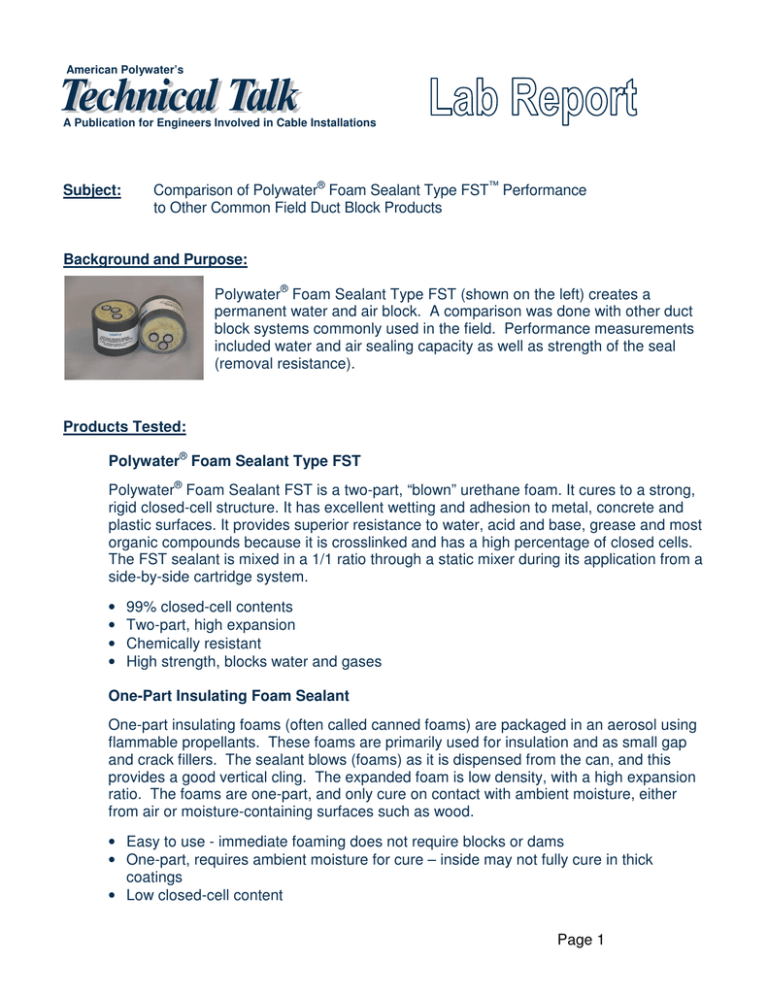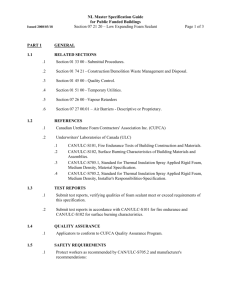
American Polywater’s
A Publication for Engineers Involved in Cable Installations
Subject:
Comparison of Polywater® Foam Sealant Type FST™ Performance
to Other Common Field Duct Block Products
Background and Purpose:
Polywater® Foam Sealant Type FST (shown on the left) creates a
permanent water and air block. A comparison was done with other duct
block systems commonly used in the field. Performance measurements
included water and air sealing capacity as well as strength of the seal
(removal resistance).
Products Tested:
Polywater® Foam Sealant Type FST
Polywater® Foam Sealant FST is a two-part, “blown” urethane foam. It cures to a strong,
rigid closed-cell structure. It has excellent wetting and adhesion to metal, concrete and
plastic surfaces. It provides superior resistance to water, acid and base, grease and most
organic compounds because it is crosslinked and has a high percentage of closed cells.
The FST sealant is mixed in a 1/1 ratio through a static mixer during its application from a
side-by-side cartridge system.
•
•
•
•
99% closed-cell contents
Two-part, high expansion
Chemically resistant
High strength, blocks water and gases
One-Part Insulating Foam Sealant
One-part insulating foams (often called canned foams) are packaged in an aerosol using
flammable propellants. These foams are primarily used for insulation and as small gap
and crack fillers. The sealant blows (foams) as it is dispensed from the can, and this
provides a good vertical cling. The expanded foam is low density, with a high expansion
ratio. The foams are one-part, and only cure on contact with ambient moisture, either
from air or moisture-containing surfaces such as wood.
• Easy to use - immediate foaming does not require blocks or dams
• One-part, requires ambient moisture for cure – inside may not fully cure in thick
coatings
• Low closed-cell content
Page 1
Duct Seal Putty
Duct seal putties are clay based molding material. These non-drying putties are kneaded
and pressed into place. They are not recommended for outdoor use. The putties
become harder and more difficult to knead in cold weather. Duct seal putties do not cure
or set up and may flow or sag over time.
• Easy to use, molds into holes and gaps
• Non-curable, may sag over time
• Non-conducting
Testing and Results:
Test
1.0
Testing Description
Pages
Installation Methods and Testing
2
Expansion Ratio, Cure Time, Closed-cell Contents
2.0
3.0
3
Functional Properties
Water Blocking Capacity
3
Air Blocking Capacity
5
Strength and Removal Characteristics
6
Service Life
Integrity of Seal and Sag Testing
1.
Installation Methods and Testing
1.1
Installation Instructions and Method
6
Polywater® FST™ Foam Sealant
The FST Foam was injected into the duct according to the instructions. Both conduit and
cables were cleaned with an HP-158ID Preparation Wipe. A foam strip dam was
wrapped in and around the cable(s) and inserted 5 inches into the conduit. Another dam
was placed at the end of the conduit, leaving a 3-inch space between the dams. The
two-part FST Foam sealant was injected through a static mixer into the open space and
allowed to foam and cure for two hours.
One-Part Insulating Foam Sealant
The insulating foam sealants do not have specific instructions for duct sealing, so the
general use instructions were adapted. Both conduit and cables were cleaned and dried
before use. The foam sealant can was shaken for 30 to 60 seconds, and the foam was
sprayed directly into conduit. For the water blockage test, the foam was added to an
Page 2
approximate depth of six inches. For the pull-out testing, approximately 12 inches of
foam was added.
Usage Limitations:
This end use is non-standard for this type of product. The general instructions
recommended that insulating foam sealant not be applied in bead sizes greater than 3
inches or into “excessively deep cavities where ambient moisture is unavailable for foam
curing.” The one part insulating foam sealants did not consistently cure and harden when
injected into conduits.
Duct Seal Putty
Duct seal putty was used as directed. The putty compound was kneaded, formed and
pushed into the duct opening. In this testing, the compound was pressed into the conduit
to a depth of one inch. Care was taken to eliminate any cracks or crevasses in the final
seal.
Usage Limitations:
Duct seal putties are intended to seal conduit openings against drafts, dust, moisture and
noise. These compounds are not intended for outdoor use. Unlike the foam products,
duct seal putties do not react and cure. These compounds do not harden over time, and
remain relatively soft.
1.2
Curing Properties
Set Time
Cure Time
Expansion
Ratio
Closed-cell
Content
FST Foam Sealant
15 Minutes
20 Minutes
10X
>99%
One-Part Insulating
Foam Sealant
6-9 Minutes
(Outside tack free)
12 Hours
(Partial Cure)
20X
>12%
Immediate
No cure
No
Expansion
NA
Duct Seal Putty
2.0
2.1
Performance Properties
Water Blocking
One-Part Insulating Foam Sealant and Duct Seal Putty
In this testing, the Insulating Foam Sealant was injected into a 2-foot section of PVC duct
to an approximate depth of 6 inches. The duct seal putty was pressed into a 2-foot
section of PVC duct to a depth of one inch. The conduit was hung vertically and water
Page 3
was added to the duct in increments of one inch. The depth of water when leakage
occured was recorded as the water-head pressure the seal could withstand.
Polywater® Foam Sealant Type FST™
Polywater® Foam Sealant holds much higher levels of water-head pressure. Testing on
this foam required higher pressure and had a modified design.
In this test, American Polywater’s Foam Sealant (FST) was injected into a duct according
to the instructions to a depth of 3 inches. A small amount (approximately 8 ounces) of
colored water was loaded into the vertical duct above the foam. Air pressure was placed
on the system to create a water-head. 7.25 psi air pressure is approximately 50 kPa or 5
meters (16.4 feet) of water-head pressure. The whole system was placed in a bucket of
clear water. (Figure 1). Seal failure can be detected by the appearance of colored water.
Because Polywater’s Foam Sealant is a light yellow color, the method of failure can also
be determined by following the color migration.
Air Line
Pressure Gauge
Fitting
PVC Pipe
Colored Water
Foamed Urethane
Seal
Pail of Clear Water
Cable(s)
Figure 1
Length of Test
Water-head Seal
Capacity
FST Foam Sealant
30 days
16.4 feet
One Part Insulating
Foam Sealant
24 hours
0.25 foot
1 week
1 foot
Duct Seal Putty
Page 4
Polywater® Foam Sealant Type FST™, Multiple Cables
The Polywater® FST foam was tested under additional, more extreme conditions. A 2inch Schedule 40 PVC duct and three polyethylene jacketed cables were sealed.
Polywater® Foam Sealant was injected to a 3-inch thickness according to the instructions.
The duct was in a horizontal position during the foaming process.
The conduit was hung vertically and the cables were bent and pulled to stress the sealant
bond.
FST Foam Sealant Condition
Three cables in system (basic)
Same cables are bent at a 45°
angle and held for 5 minutes in
two directions
Same cables are pulled with 15
lbs. axial force for 4 hours
2.2
Length of Test
15 Minutes
Water-head Seal
Capacity
40 psi
(92 feet waterhead)
15 Minutes
40 psi
(92 feet waterhead)
15 Minutes
40 psi
(92 feet waterhead)
Air Pressure Stop
In this test, the duct sealants were installed as described in Section 1.1. Clear, 2-inch
schedule 40 PVC duct was used. The duct was swabbed with a Polywater® HP-158ID
solvent wipe prior to sealant installation. Polywater® Foam Sealant was injected to a
depth of 3 inches, the insulating foam sealant to a depth of 6 inches, and the duct seal
putty to a depth of 1 inch.
A balloon was placed over the end of the duct and an air fitting was placed on the other
end of the duct. Air pressure was placed on the system to create a pressurized system.
(See Figure 2.) Seal failure was detected when the balloon filled and expanded. The
duct block was step-up pressurized to 5 psi, 10 psi, 20 psi and 30 psi with a holding
period of 168 hours at each pressure.
Air Line
Pressure Gauge
Fitting
PVC Pipe
Foamed Urethane
Seal
Balloon
Figure 2
Page 5
Length of Test
FST Foam Sealant
One-Part Insulating
Foam Sealant
Duct Seal Putty
2.3
4 steps
168 hours each
Immediate
Leakage
Immediate
Leakage
Air Pressure
Seal Capacity
>30 psi
<1 psi
<1 psi
Cable Pull-out and Strength of Seal
In this test, three wires were sealed into a clear, 2-inch schedule 40 PVC conduit using
the sealants as described in 1.1. Care was taken to inject or mold the compound into the
spaces between each wire. The conduit section was then clamped into an Instron tensile
testing machine. Cables were pulled out (speed of 2 in/min) of the foam individually
when possible. Maximum pull-out force was recorded. Results are the average of three
tests each on 2 AWG THHN copper cable and 4/0 XHHW aluminum cable.
Cable Type
Average
Pull-Out Force (lbf)
FST Foam Sealant
2 AWG THHN
171
FST Foam Sealant
4/0 XHHW
320
One-Part Insulating
Foam Sealant
4/0 XHHW
86*
Not Applicable
Not Applicable
Duct Seal Compound
* For the One-Part Insulating Foam Sealant, all three cables came out together. The
values reported for FST Foam Sealant represents an average pull tension for each of
three cables.
3.0
3.1
Service Life
Integrity of Seal and Sag Testing
After duct sealant compound was injected into ducts as described in Section 1.1, the
seals were allowed to age for 6 months. Any deformation was measured. Seals were
sliced open for inspection.
Page 6
Description of Seal
FST Foam Sealant
One-Part Insulating
Foam Sealant (Canned
Foam)
Duct Seal Putty
Permanent, structural block. Remains intact with
good adhesion to conduit wall and cable material.
Resistant to uv, water, and chemicals.
Rigid, blocking foam. Cure is inconsistent in duct
application. Patches of soft, uncured material found,
showing flow character and voids.
Soft, malleable putty. Material shows sagging and
deformation.
Discussion:
When used properly Polywater’s FST™ Foam Sealant can hold a water-head pressure up to 30
psi or 60 feet of water head. It has high closed-cell content and will seal air under pressure.
The foam sealant will seal between multiple cables and tolerates cable movement and stress.
The FST foam, applied in sufficient thickness, is impervious to water, as is the adhesive bond to
both the PVC or HDPE conduit and PE cable jacket.
One-Part Insulating Foam Sealants and Duct Seal Putties show poor performance. They do not
block water and air or prevent cable removal.
Appendix 1 – Products Used in Testing
Dow® Great Stuff™ Window and Door
Dow® Great Stuff™ Gap and Crack
Dow® Fill N Seal
Dap®Tex® Multi-Purpose Foam Sealant
GB® Duct Seal Compound
EPD Duct Seal Compound
Topic Related Links
FST™ Foam Duct Sealant
Polywater Home Page Link
Copyright © 2009. American Polywater Corporation. All rights reserved.
3/2009
Page 7



